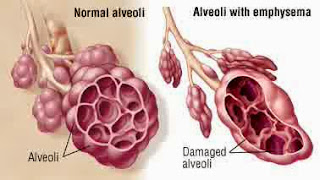Nursing Care Plan for Encephalitis
Encephalitis is an infection of the CNS caused by viruses or other micro-organisms are non-purulent.
Pathogenesis of encephalitis
Viruses enter the patient's body through the skin, respiratory tract and gastrointestinal tract. Upon entry into the body, the virus will spread throughout the body in several ways:
1 Local: limited flow viruses infect the mucous membrane or the surface of a particular organ.
2 Primary hematogenous Dissemination: the virus into the blood then spread to organs and breed in these organs.
3 Spread through the nerves: Surface viruses multiply in the mucous membranes and spreads through the nervous system.
Prodromal period lasts 1-4 days characterized by fever, headache, dizziness, vomiting, sore throat, malaise, pain in the extremities and pale.
Other symptoms such as anxiety, irritable, behavior changes, disturbance of consciousness, seizures.
Sometimes accompanied Neurological signs such as Aphasia, Hemiparesis, Hemiplegia, Ataxia, brain nerve paralysis.
Symptoms that may occur in Encephalitis:
Increased body heat, photo phobia, headache, vomiting, lethargy, sometimes accompanied by a stiff neck when the infection of the meninges.
Children looked nervous sometimes accompanied by changes in behavior. May be accompanied by impaired vision, hearing, speech and seizures.
Assessment
1. Identity
Encephalitis can occur in all age groups.
2 The main complaint
Increased body heat, seizures, decreased consciousness.
3. History of present illness
At first the child cranky, restless, vomiting, increased body heat approximately 1-4 days, headache.
4. Past medical history
Previous clients suffering from coughs, colds approximately 1-4 days, had suffered from herpes disease, infectious disease of the nose, ears and throat.
5. Family Health History
There families who suffer from diseases caused by viruses eg herpes etc.. Bacteria example: Staphylococcus aureus, Streptococcus, E-Coli, etc..
6 Immunization
When was the last given DTP immunization.
Because encephalitis can occur post pertussis immunization.
Growth and Development.
Nursing Diagnosis : Risk for Infection related to the body's resistance to infection down.
Goal: prevent infection
Criteria results:
Timely healing period without evidence of spread of infection endogenous.
Intervention
1. Defense aseptic technique and proper hand washing techniques either officers or visitors. Monitor and limit visitors.
R /: Reduce the risk of secondary infection. Controlling the spread of infection source.
2 Observations temperature regularly and clinical signs of infection.
R /. Early detection of signs of infection is an indication of the development of meningococcemia.
3 Give antibiotics as indicated.
R /. Drugs are selected depending on the type of infection and sensitivity of the individual.
Nursing Diagnosis : Risk for trauma related to generalized seizure activity.
Purpose: There was no trauma.
Criteria results:
Not having a seizure / other concomitant injuries.
Intervention:
1 Provide security for patients by giving pads, bed barriers remain attached and give a booster in the mouth, airway remains free.
R /: Protecting the patient in the event of a seizure, a booster mouth so that the tongue was not bitten.
Note: enter the mouth wedge mouth only when relaxation.
2 Maintain bed rest in the acute phase.
R /: Reduce the risk of falls / trauma during the vertigo.
Collaboration
3 Give the drug as indicated.
R /. An indication for the treatment and prevention of seizures.
4 Observation of vital signs.
R /: Detection of seizures themselves can be somewhat further action.
Read More..
Encephalitis is an infection of the CNS caused by viruses or other micro-organisms are non-purulent.
Pathogenesis of encephalitis
Viruses enter the patient's body through the skin, respiratory tract and gastrointestinal tract. Upon entry into the body, the virus will spread throughout the body in several ways:
1 Local: limited flow viruses infect the mucous membrane or the surface of a particular organ.
2 Primary hematogenous Dissemination: the virus into the blood then spread to organs and breed in these organs.
3 Spread through the nerves: Surface viruses multiply in the mucous membranes and spreads through the nervous system.
Prodromal period lasts 1-4 days characterized by fever, headache, dizziness, vomiting, sore throat, malaise, pain in the extremities and pale.
Other symptoms such as anxiety, irritable, behavior changes, disturbance of consciousness, seizures.
Sometimes accompanied Neurological signs such as Aphasia, Hemiparesis, Hemiplegia, Ataxia, brain nerve paralysis.
Symptoms that may occur in Encephalitis:
Increased body heat, photo phobia, headache, vomiting, lethargy, sometimes accompanied by a stiff neck when the infection of the meninges.
Children looked nervous sometimes accompanied by changes in behavior. May be accompanied by impaired vision, hearing, speech and seizures.
Assessment
1. Identity
Encephalitis can occur in all age groups.
2 The main complaint
Increased body heat, seizures, decreased consciousness.
3. History of present illness
At first the child cranky, restless, vomiting, increased body heat approximately 1-4 days, headache.
4. Past medical history
Previous clients suffering from coughs, colds approximately 1-4 days, had suffered from herpes disease, infectious disease of the nose, ears and throat.
5. Family Health History
There families who suffer from diseases caused by viruses eg herpes etc.. Bacteria example: Staphylococcus aureus, Streptococcus, E-Coli, etc..
6 Immunization
When was the last given DTP immunization.
Because encephalitis can occur post pertussis immunization.
Growth and Development.
Nursing Diagnosis : Risk for Infection related to the body's resistance to infection down.
Goal: prevent infection
Criteria results:
Timely healing period without evidence of spread of infection endogenous.
Intervention
1. Defense aseptic technique and proper hand washing techniques either officers or visitors. Monitor and limit visitors.
R /: Reduce the risk of secondary infection. Controlling the spread of infection source.
2 Observations temperature regularly and clinical signs of infection.
R /. Early detection of signs of infection is an indication of the development of meningococcemia.
3 Give antibiotics as indicated.
R /. Drugs are selected depending on the type of infection and sensitivity of the individual.
Nursing Diagnosis : Risk for trauma related to generalized seizure activity.
Purpose: There was no trauma.
Criteria results:
Not having a seizure / other concomitant injuries.
Intervention:
1 Provide security for patients by giving pads, bed barriers remain attached and give a booster in the mouth, airway remains free.
R /: Protecting the patient in the event of a seizure, a booster mouth so that the tongue was not bitten.
Note: enter the mouth wedge mouth only when relaxation.
2 Maintain bed rest in the acute phase.
R /: Reduce the risk of falls / trauma during the vertigo.
Collaboration
3 Give the drug as indicated.
R /. An indication for the treatment and prevention of seizures.
4 Observation of vital signs.
R /: Detection of seizures themselves can be somewhat further action.






